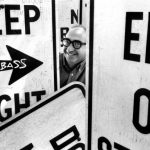2006
Eckhard Gerdes reviews Harold Jaffe's Terror-Dot-Gov: Docufictions.
Luc Herman and Bart Vervaeck review Marie Laure-Ryan's Narrative as Virtual Reality: Immersion and Interactivity in Literature and Electronic Media. They review the essential characteristics of hypertext to suggest more nuanced ways to understand realism in relation to virtual reality.
2005
1999 e-literature award winner John Cayley writes about Saul Bass of classic film title fame. A precursor to language arts innovators Jenny Holzer, Richard Kostelanetz, and Cayley himself, Bass may now be recognized as a poet in his own 'write,' important for a new generation of designwriters creating "graphic bodies of language," moving words and signifying images, in digital environments.
A Wallace Stevens conference review from poet and critic Ravi Shankar.
2004
Gregg Biglieri reads "into" Actress in the House and revels in Joseph McElroy's syntax.
A Response to Rone Shavers and impromptu review of Harold Jaffe's latest book, 15 Serial Killers, latest entry in the "literature of witness."
Joseph Tabbi reviews Joe Conte's Design and Debris and gauges the argument for chaotics-as-aesthetics across media.
2003
In looking to the future of the 'electronic book,' Ciccoricco digs up some of ebr's manifesto-like remarks of old.
Stuart Moulthrop re-opens the debate on the "electronic book" and its continued marginalization vis-a vis print.
Despite talk of endings and absences at Eastgate Systems, Dave Ciccoricco investigates continuities in the work of Michael Joyce and Mark Bernstein.
Rone Shavers argues that making readers aware of subjugation - the strategy of Harold Jaffe's False Positive - exposes little and hardly changes our relation to power.
A review of Writing Machines, building on a number of the book's earlier reviewers in ebr and elsewhere.
Jim Rosenberg sends a shot of grammar straight across the bow of Nick Montfort's controversial Cybertext review, adding volume to a volley already in progress.
Scott Rettberg introduces 'New Media Studies': a cluster of reviews, and a term (similar in its emergence to the term 'Postmodernism').
A book about books conscious of their materiality, N. Katherine Hayles' Writing Machines draws praise from Raine Koskimaa for its own media consciousness, and blame for embodied emphasis.
Over 800 pages, the New Media Reader does not exhaust its subject; it even sets the stage for a companion volume.
Form and platform are bridged in Stephanie Strickland's "V: WaveSon.nets/Losing L'una," a book with two beginings and a website to boot. Chris Funkhouser tests the load limit of this innovative, precarious structure.
Rob Wittig looks at one of the earliest "Weblogs," and finds there a persisting model for serial e-fiction and an interaction no less compelling than the literary correspondence between Henry Miller and Anais Nin.
Scott Rettberg appreciates Weinberg's small pieces more than his 'unified theory,' while viewing the Internet not as an economic panacea but a communication medium woven into the fabric of contemporary culture.

